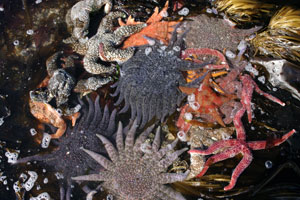Tidepooling in Alaska
Etiquette
 Whether you are digging for clams, leading a classroom field trip to the beach, or just exploring Alaska's coastline, remember that the shoreline is home to myriad marine creatures. An amazing array of marine invertebrates - sea animals without backbones - live within the intertidal zone between the water's edge and the high tide line. Every year, a growing number of residents, local and visiting students and tourists venture into their habitat. Every time you walk in the intertidal zone of a beach you run the risk of disrupting these animals' lives, but if you take care, you can minimize the damage and maximize your enjoyment. You can also find other, less intrusive, opportunities to view, touch, and learn about intertidal ecology on pilings and docks, or at live tanks and aquaria at nature centers and museums.
Whether you are digging for clams, leading a classroom field trip to the beach, or just exploring Alaska's coastline, remember that the shoreline is home to myriad marine creatures. An amazing array of marine invertebrates - sea animals without backbones - live within the intertidal zone between the water's edge and the high tide line. Every year, a growing number of residents, local and visiting students and tourists venture into their habitat. Every time you walk in the intertidal zone of a beach you run the risk of disrupting these animals' lives, but if you take care, you can minimize the damage and maximize your enjoyment. You can also find other, less intrusive, opportunities to view, touch, and learn about intertidal ecology on pilings and docks, or at live tanks and aquaria at nature centers and museums.
It's illegal to remove animals you aren't going to eat without an ADF&G Aquatic Resource Permit. You can learn more about the requirements for scientists and educators under "Collecting and Harvesting."
Here are some tips to help conserve tide pools:
- Walk, don't run. You may trip and fall in unfamiliar terrain. Walking also exerts less pressure on the animals.
- Step on bare rock rather than on a living organism wherever possible.
- Explore along the exposed beach or from the edge of a tidepool rather than venturing into the water. This will provide better viewing conditions and allow animals to remain undisturbed.
- Turn over only small rocks and do so gently. A quick turnover may crush animals that are next to the rock or darting under the rock as their hiding place is uncovered.
- Wet your hand with seawater from the beach before touching or holding an animal exposed by the tide.
- Replace the rock carefully. Also replace seaweed or other cover for shelter.
